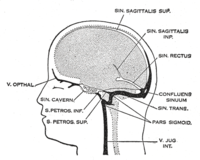
Photo from wikipedia
BackgroundAnemia is associated with unfavorable functional outcome in ischemic and hemorrhagic stroke. However, the relationship between anemia and prognosis in patients with cerebral venous thrombosis (CVT) has not been studied.MethodsConsecutive… Click to show full abstract
BackgroundAnemia is associated with unfavorable functional outcome in ischemic and hemorrhagic stroke. However, the relationship between anemia and prognosis in patients with cerebral venous thrombosis (CVT) has not been studied.MethodsConsecutive CVT patients were retrospectively identified from November 2011, through January 2017. Anemia was defined according to the World Health Organization criteria (non-pregnant female hemoglobin level < 120 g/L, pregnant female < 110 g/L and male < 130 g/L), which was further classified as mild, moderate, and severe anemia according to hemoglobin concentration, and as microcytic, normocytic, and macrocytic anemia according to mean corpuscular volume. Unfavorable outcome was defined as modified Rankin Scale (mRS) of 3–6. Factors such as age, sex, coma, malignancy, intracerebral hemorrhage, and straight sinus and/or deep CVT involved, premorbid mRS were adjusted to evaluate the relationship between anemia and prognosis in CVT patients.ResultsA total of 238 CVT patients were included, among whom 73 patients (30.67%) were diagnosed with anemia. Multivariate logistic regression analysis showed that patients with anemia had a higher risk of mRS of 3–6 (OR = 3.62; 95% CI, 1.45–9.01; P = 0.006) and mortality (OR = 5.46; 95% CI, 1.90–15.70; P = 0.002). Subgroup analysis showed that severe anemia was independently associated with mRS of 3–6 (OR = 8.80; 95% CI, 1.90–40.81; P = 0.005) and mortality (OR = 9.82; 95% CI, 1.81–53.25; P = 0.010). Similarly, microcytic anemia increased the risk of mRS of 3–6 (OR = 4.64; 95% CI, 1.48–14.52; P = 0.008) and mortality (OR = 9.68; 95% CI, 2.61–35.91; P = 0.001). In addition, our study also revealed that lower hemoglobin level, evaluated as a continuous variable, was inversely associated with mRS of 3–6 (OR = 0.98; 95% CI, 0.96–0.99; P = 0.007) and mortality (OR = 0.97; 95% CI, 0.95–0.99; P = 0.005).ConclusionsAnemia was a significant and independent predictor of unfavorable functional outcome in patients with CVT.
Journal Title: Neurocritical Care
Year Published: 2018
Link to full text (if available)
Share on Social Media: Sign Up to like & get
recommendations!